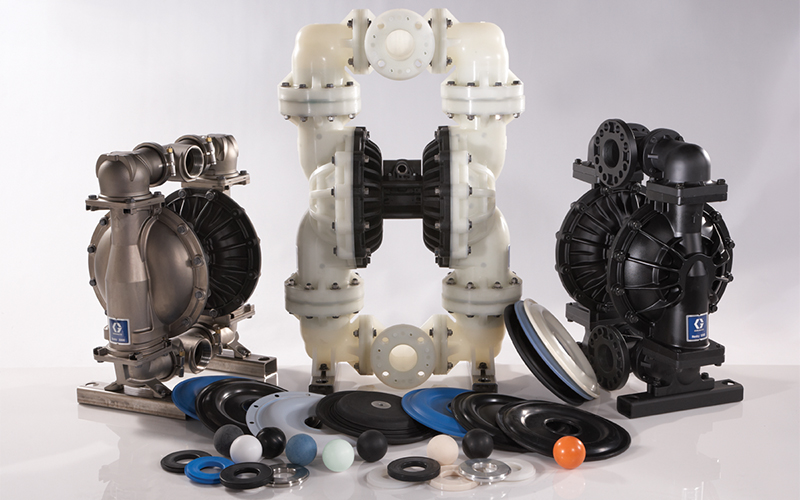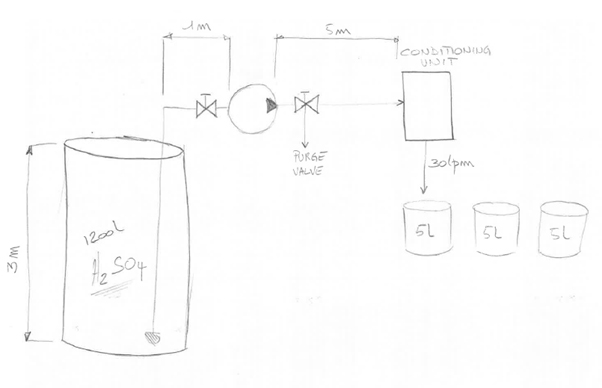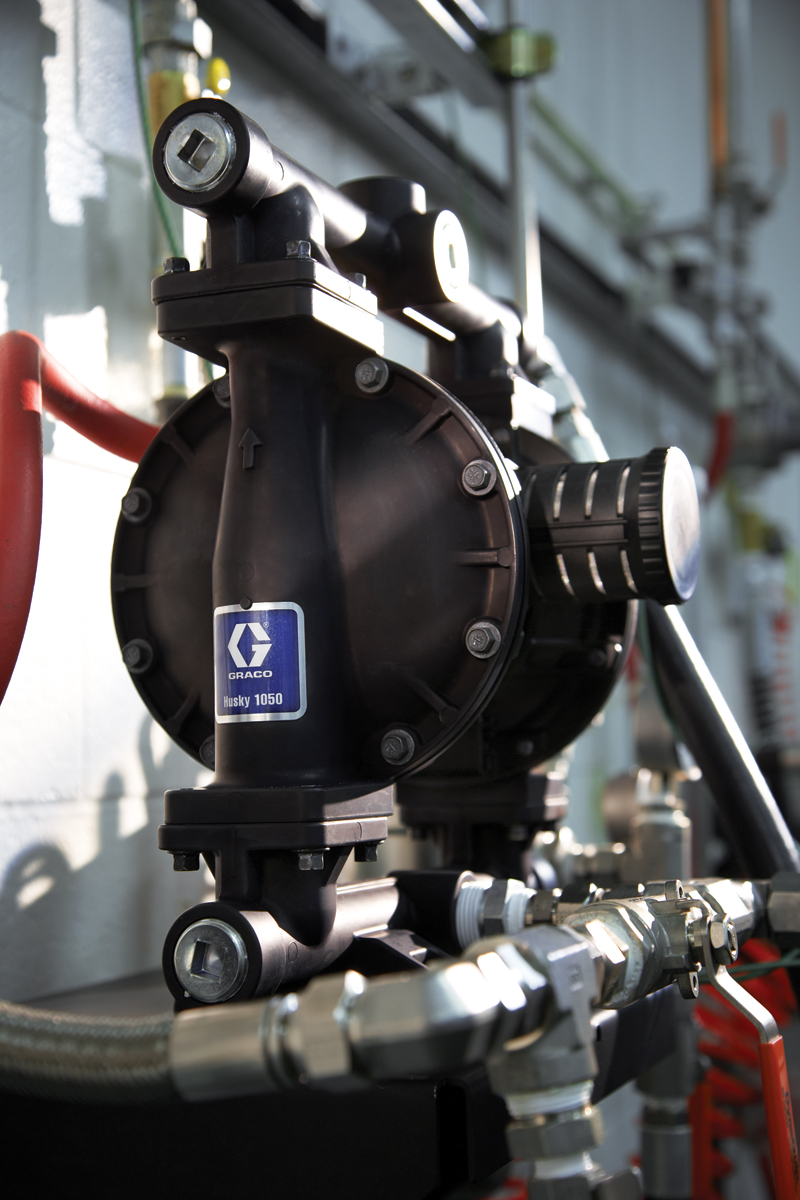How to select the correct Husky pump
Air-operated double diaphragm pumps are the preferred pumps in many industries as they perform well in a broad array of applications.
Graco Husky AODD pumps can handle a wide range of chemicals, flow rates and viscosities. But how do you choose the best pump for your specific application? Here are a few guidelines to help.
Graco’s Air-Operated Double Diaphragm (AODD) Husky pumps are available in metal and plastic housings, take balls, seats and diaphragms of various materials, and offer a wide range of flow rates and sizes. To select the right Husky pump for your specific application, a few questions need to be answered.
What fluid will it be pumping? Every fluid has its own characteristics. Pumping water requires a different approach to pumping glue, an epoxy, tomato paste or an acid. Understanding the characteristics of the fluid is the first step towards choosing a suitable pump.
What’s the application? Are you feeding a pump or another machine? Are you transferring fluid, unloading a tank, or is it a potting or some other application?
What’s the diameter of the pipes? A double diaphragm pump delivers a lot of volume but at low pressure, so pipe diameter needs to be as high as possible. How much volume do you need for your application?
Where will the pump be positioned? Are you creating suction height? What length of suction hoses are you intending to use? Discharge length is a big factor; the longer the discharge length, the more pressure losses you will experience.
Intermittent or continuous operation? If your pump will be running 24/7, you may need to go to a lower cycle rate, which means a larger pump size and thus a higher price. However, a lower cycle rate results in less wear of the packings, diaphragms, seats, and balls, resulting in reduced maintenance costs.
Do you need ATEX certification? If the pump is going to operate in a hazardous environment you may need to choose a pump with ATEX approval. ATEX certification ensures that equipment will work safely in an explosive environment without causing an accident, if used as per the manufacturer's recommendations.

An example: sulfuric acid
Let’s answer those questions by using a typical application: pumping sulfuric acid. Your first step is to look at the technical data sheet of sulfuric acid. Sulfuric acid has a low viscosity of 26.7 cPs at 21oC. Knowing the viscosity is especially relevant to choosing the right material for the pump ball and seat.
Density is important too because it determines the maximum suction height of the application. Sulfuric acid has a density of 1.84 kg/l. As this is almost double that of water, sulfuric acid is therefore a heavy fluid. This will impact the balls you choose for the pump.
Secondly, check the Graco Chemical Compatibility Guide. It enables you to immediately see which metals and plastics are either compatible or incompatible with sulfuric acid. According to this guide, sulfuric acid is compatible with polypropylene, Santoprene®, PTFE and Viton®. Cost immediately comes into play, as Viton® is the most expensive of the four, with polypropylene the cheapest.
The next step is to know at what temperature the sulfuric acid will be pumped, as polypropylene will melt above 65oC. If your sulfuric acid is being pumped at 75oC, you’ll have to consider a more temperature-resistant plastic such as Kynar® (PVDF) or PTFE, or a metal such as Hastelloy®, although this has a price disadvantage. But if your application is running at an ambient temperature of say 20oC, you could use a pump with a polypropylene body and Santoprene inner parts.
A typical sulfuric acid pumping application

Going into more detail on the application: you want to pump sulfuric acid at 20oC from a 1200-liter tank to feed a conditioning unit that over the course of a day will fill 5-liter barrels at a speed of 30 liters per minute. The feed tank is 3 meters high and then there is 1 meter of horizontal pipe followed by a 5-meter discharge pipe.
At a speed of 30 liters per minute, your pump will have a duty cycle of only 40 minutes, so it’s operating intermittently. By using the Graco Suction Loss Calculation Sheet you will discover that the estimated suction losses for such a setup are 0.59 bar. This leaves 0.41 bar remaining, which should be sufficient.
We advise that with high suction heights and heavy fluids such as sulfuric acid it’s worth putting an exit check valve at the bottom of the 1200-liter barrel. This will ensure that the wet suction is always higher than the dry suction. Another recommendation is to lower your pump if possible. This not only ensures you make the most of gravity, but also allows for perfect priming of the pump.
Which Husky pump to choose for pumping sulfuric acid?
By now you have a better picture of the application details and the materials that are compatible with sulfuric acid. So it’s time to consider the Husky pumps that would fit the specifications.
From the wide range of Graco Husky pumps, several would be feasible:
- 1-inch Husky 1050
For this sulfuric acid application, the pump would have a cycle volume of 0.64 liters per cycle and would run at 47 cycles per minute. Its Santoprene® or Viton® inner parts offer flexibility, long life and resistance against mechanical stresses.
- ½-inch Husky 1590
With this larger pump, the cycle volume would increase to 1.96 liters per cycle and it would run at only 16 cycles per minute. This is low but has the benefit of fewer pulsations. The Husky 1590 would be a perfect solution for a continuous duty application, or if a slow running pump is needed. But for an intermittent application, the Husky 1050 is satisfactory, and also cheaper.
- 1½-inch Husky 15120
This pump would offer an even higher cycle volume of 2.4 liters per cycle at 12.5 cycles per minute. The reason to consider the Husky 15120 is that it is extremely resistant against acids. This is due to the single-piece center that is made completely from polypropylene. Moreover, key sections of the body are made from glass-fiber reinforced polypropylene to give it extra strength and chemical resistance. This pump is also available in conductive polypropylene or Hastelloy® for applications where ATEX approval is required. Hastelloy® is a metal that offers extremely high chemical and mechanical resistance, but is very expensive.
- The Husky 1040 ChemSafe
This is another pump that is designed to handle extremely harsh acids. It has a totally encapsulated body, made either from PTFE (to withstand temperatures up to 100oC) or polypropylene (for temperatures up to 70oC).
All the Husky pumps are very easy to maintain. Only four bolts need to be removed to access the air valve in case of replacement. The pilot valves are also easily accessible. The pumps are lubricated for life. However, when maintaining the air valve or inner components, a little lithium grease can be provided. On the rear of the pump is the muffler, which is also easily accessible. Simply unscrewing it will enable it to be checked for any moisture or grease in the air supply. Dry and clean compressed air is always recommended.

Selecting the right balls
With a high-density fluid such as sulfuric acid, a heavier ball will be needed, such as one made from Viton® or PTFE. Viton® is more expensive than PTFE, but as it is more dense and therefore heavier it will give a better suction. This is a key consideration for the sulfuric acid application with its 3-meter suction height. Santoprene® would not be a good option for this application as Santoprene is lighter than water. Balls made from Santoprene® will float on most fluids.
Overview of Husky pumps for the sulfuric acid application
For a low cost, no ATEX solution:
- Husky 1050 polypropylene body + Santoprene®/Viton® inner parts
- Husky 1590 polypropylene body + Santoprene®/Viton® inner parts
For a low cost pump with ATEX approval:
- Husky 1050 conductive polypropylene body + Santoprene®/Viton® inner parts
For a high temperature pump, no ATEX approval:
- Husky 1050 PVDF body + PTFE inner parts
- Husky 1590 PVDF body + PTFE inner parts
For a high temperature pump with ATEX approval:
- Husky 1050 Hastelloy® body + polypropylene center section + PTFE inner parts
For a low cost chemical pump with no ATEX approval:
- Husky 15120 polypropylene center section + Santoprene® inner parts
- ChemSafe 1040 full PTFE body + PTFE diaphragm
- ChemSafe 1040 full polypropylene body + PTFE diaphragm
How much air do these pumps consume?
A double diaphragm pump consumes a lot of air. So don’t forget to add the cost of an air compressor into your calculations. Typically, a pump running continuously could easily consume 750-850 liters per minute. However, in practice this is very unlikely as these pumps usually run intermittently. Your air compressor supplier will be able to advise on the best air compressor to use for your specific application.
Need help choosing your pump?
Graco offers some helpful tools on its website. The Chemical Compatibility Guide is an excellent general guideline for pump selection and to determine compatible materials, not only for the fluid being pumped but also for the cleaning agent to be used. Another useful guide is the Materials of Construction Guide which allows you to find the most cost-effective match for your application. And last but not least, the Pneumatic Diaphragm Pump Selector will help you select the right pump for your specific application.
If you require further assistance, or would like to see a demonstration of a Husky AODD pump, please fill in the contact form below.
Santoprene® is a registered trademark of Advanced Elastomer Systems, L.P. Hastelloy® is a registered trademark of Haynes International, Inc. Viton® is a registered trademark of The Chemours Company. Kynar® is a registered trademark of Arkema Inc. Hytrel® is a registered trademark of DuPont.
Related Articles
How to master fluid and material properties of a diaphragm pump
Graco’s Husky Air-Operated Double Diaphragm (AODD) pumps are one of the most reliable and efficient pumps on the market. But to get the best performance out of them means selecting the right pump with the right components for every application.
How to configure a diaphragm pump with confidence – Part 1
The Graco website contains tools to simplify the selection and configuration of a diaphragm pump for a specific application.



